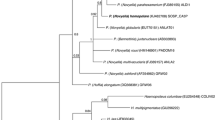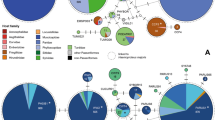Abstract
The DNA sequence information on avian malaria parasites of the genus Plasmodium is quite limited. At present, sequences of only 6 out of 34 valid species are available. However, sequence data of avian malaria parasites are particularly important with regard to the resolution of the phylogenetic relationships of the most virulent human malaria agent, Plasmodium falciparum. The question as to whether P. falciparum originates from avian or from mammalian parasites would contribute to our understanding of its biology and would probably facilitate the interpretation of experimental results. To add to the body of molecular data, we sequenced three genes (cytochrome b, 18 SSU rRNA, caseinolytic protease C) of different organellar origin of one of the most widespread avian malaria parasites, Plasmodium (Haemamoeba) cathemerium, which once used to be an important laboratory in vivo model in human malaria research. The analysis of the new P. cathemerium sequences in direct comparison with the rodent parasite P. berghei and the four human malaria parasites by pairwise distance calculation do not suggest a closer relationship of P. cathemerium to P. falciparum than to the other species involved.
Similar content being viewed by others
References
Ayala FJ, Escalante AA, Rich SM (1999) Evolution of Plasmodium and the recent origin of the world populations of Plasmodium falciparum. Parassitologia 41:55–68
Babiker HA, Walliker, D (1997) Current views on the population structure of Plasmodium falciparum: implications for control. Parasitol Today 13:262–267
Bennet GF, Bishop MA, Peirce MA (1993) Checklist of the avian species of Plasmodium Marchiafava & Celli, 1885 (Apicomplexa) and their distribution by avian family and Wallacean life zones. Syst Parasitol 26:171–179
Benning TL, LaPointe D, Atkinson CT, Vitousek PM (2002) Interactions of climate change with biological invasions and land use in the Hawaiian islands: modeling the fate of endemic birds using a geographic information system. Proc Natl Acad Sci USA 29:14246–14249
Bensch S, Stjernman M, Hasselquist D, Östman Ö, Hansson B, Westerdahl H, Pinheiro RT (2000) Host specifity in avian blood parasites: a study of Plasmodium and Haemoproteus mitochondrial DNA amplified from birds. Proc R Soc Lond B 267:1583–1589
Boyd MF (1948) Malariology. Saunders, Philadelphia
Coluzzi M (1999) The clay feet of the malaria giant and its African roots: hypotheses and inferences about origin, spread and control of Plasmodium falciparum. Parassitologia 41:277–283
Escalante AA, Ayala FJ (1994) Phylogeny of the malarial genus Plasmodium, derived from rRNA gene sequences. Proc Natl Acad Sci USA 91:11373–11377
Escalante AA, Goldman IF, de Rijk P, de Wachter R, Collins WE, Qari SH, Lal AA (1997) Phylogenetic study of the genus Plasmodium based on the secondary structure-based alignment of the small subunit ribosomal RNA. Mol Biol Parasitol 90:317–321
Escalante AA, Freeland DE, Collins WE, Lal AA (1998) The evolution of primate malaria parasites based on the gene encoding cytochrome b from the linear mitochondrial genome. Proc Natl Acad Sci USA 95:8124–8129
Fink E, Dann O (1967) Eine Weiterentwicklung des Roehl-Test zur Prüfung von Malariamitteln anPlasmodium cathemerium beim Kanarienvogel durch intravenöse Verabreichung. Zschr Tropenmed Parasitol 18:466–474
Garnham PCC (1963) Malaria parasites and other Haemosporida. Blackwell, Oxford
Gehring CU (1974) Versuche zur Übertragung von Plasmodium cathemerium, einem der Vogelmalariaerreger, auf weiße Mäuse. PhD Thesis, University of Bonn
Joy DA, Feng X, Mu J, Furuya T, Chotivanich K., Krettli AU, Ho M, Wang A, White NJ, Suh E, Beerli P, Su X (2003) Early origin and recent expansion of Plasmodium falciparum. Science 300:318–321
Kedzierski L, Escalante AA, Isea R, Black CG, Barnwell JW, Coppel RL (2002) Phylogenetic analysis of the genus Plasmodium based on the gene encoding adenylsuccinate lyase. Infect Genet Evol 1:297–301
Killick-Kendrick R, Peters W (1978) Rodent malaria. Academic, London, New York, San Francisco
Kissinger JC, Souza PC, Soares CO, Paul R, Wahl AM, Rathore D, McCutchan TF, Krettli, AU (2002) Molecular phylogenetic analysis of the avian malarial parasite Plasmodium (Novyella) juxtanucleare. J Parasitol 88:769–773
Kumar S, Tamura K, Jakobson IB, Nei M (2001) MEGA 2: molecular evolutionary genetics analysis software. Bioinformatics 17:1244–1245
Landau I (1965) Description de Plasmodium chabaudi n. sp. de rongeur Africains. C R Hebd Séances Acad Sci 260:3758–3761
Landau I, Killick-Kendrick R (1966) Note préliminaire sur le cycle évolutif des deux Plasmodium du rongeur Thamnonmys rutilans de la République Centrafricaine. C R Hebd Séances Acad Sci 262:1113–1116
Landau I, Miltgen F, Chabaud A-G (1976) Les différents de gamétocytes chez les Hémosporidies de Mammifères. Ann Parasitol Hum Comp 51:175–187
Livingstone FB (1958) Anthropological implications of sickle cell gene distribution in West Africa. Am Anthropol 60:533–562
McCutchan TF, Kissinger JC, Touray MG, Rogers MJ, Li J, Sullivan M, Braga EM, Krettli AU, Miller LH (1996) Comparison of circumsporozoite proteins from avian and mammalian malarias: biological and phylogenetic implications. Proc Natl Acad Sci USA 93:11889–11894
Newbold C, Craig A, Kyes S, Rowe A, Fernandez-Reyes D, Fagan T (1999) Cytoadherence, pathogenesis and the infected red cell surface in Plasmodium falciparum. Int J Parasitol 29:927–937
Perkins SL, Schall JJ (2002) A molecular phylogeny of malarial parasites recovered from cytochrome b gene sequences. J Parasitol 88:972–978
Peters W (1987) Chemotherapy and drug resistance in malaria, vol 1, 2nd edn. Academic, London
Poolsuwan S (1995) Malaria in prehistoric southeastern Asia. Southeast Asian J Trop Med Public Health 26:3–22
Qari SH, Shi YP, Pieniazek NJ, Collins WE, Lal AA (1996) Phylogenetic relationship among the malaria parasites based on small subunit rRNA gene sequences: monophyletic nature of the human malaria parasite, Plasmodium falciparum. Mol Phylogenet Evol 6:157–165
Rathore D, Wahl AM, Sullivan M, McCutchan TF (2001) A phylogenetic comparison of gene trees constructed from plastid, mitochondrial and genomic DNA of Plasmodium species. Mol Biochem Parasitol 114:89–94
Roehl W (1926) Die Wirkung des Plasmochins auf die Vogelmalaria. Naturwissenschaften 14:1156–1159
Schrenzel MD, Maalouf GA, Keener LL, Gaffney PM (2003) Molecular characterization of malarial parasites in captive passerine birds. J Parasitol 89:1025–1033
Siddall ME, Barta JR (1992) Phylogeny of Plasmodium species: estimation and inference. J Parasitol 78:567–568
Thompson JD, Gibson TJ, Plewniak F, Jeanmougin F, Higgins DG (1997) The ClustalX windows interface: flexible strategies for multiple sequence alignment aided by quality analysis tools. Nucleic Acids Res 25:4876–4882
Vincke IH, Lips M (1948) Un nouveau Plasmodium d’un rongeur sauvage du Congo, Plasmodium berghei n. sp. Ann Soc Belg Med Trop 28:97–104
Walker HA, Richardson AP (1948) Potentiation of the curative action of 8-aminoquinolines and naphthoquinones in avian malaria. J Natl Mal Soc 7:4–11
Wang L, Webster DE, Wesselingh SL, Coppel RL (2004) Orally delivered malaria vaccines: not too hard to swallow. Exp Opin Biol Ther 4:1585–1594
Waters AP, Higgins DG, McCutchan TF (1991) Plasmodium falciparum appears to have arisen as a result of lateral transfer between avian and human hosts. Proc Natl Acad Sci USA 88:3140–3144
Waters AP, Higgins DG, McCutchan TF (1993) Evolutionary relatedness of some primate models of Plasmodium. Mol Biol Evol 10:914–923
White NJ (2004) Antimalarial drug resistance. J Clin Invest 113:1084–1092
Acknowledgements
The study was partially supported by the Deutsche Ornithologen-Gesellschaft.
Author information
Authors and Affiliations
Corresponding author
Rights and permissions
About this article
Cite this article
Wiersch, S.C., Maier, W.A. & Kampen, H. Plasmodium (Haemamoeba) cathemerium gene sequences for phylogenetic analysis of malaria parasites. Parasitol Res 96, 90–94 (2005). https://doi.org/10.1007/s00436-005-1324-8
Received:
Accepted:
Published:
Issue Date:
DOI: https://doi.org/10.1007/s00436-005-1324-8




